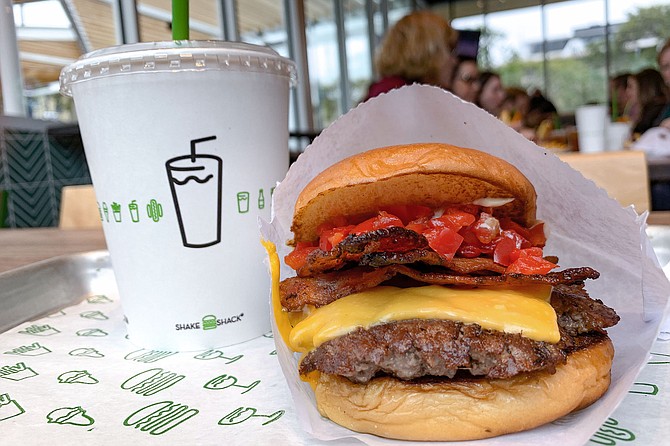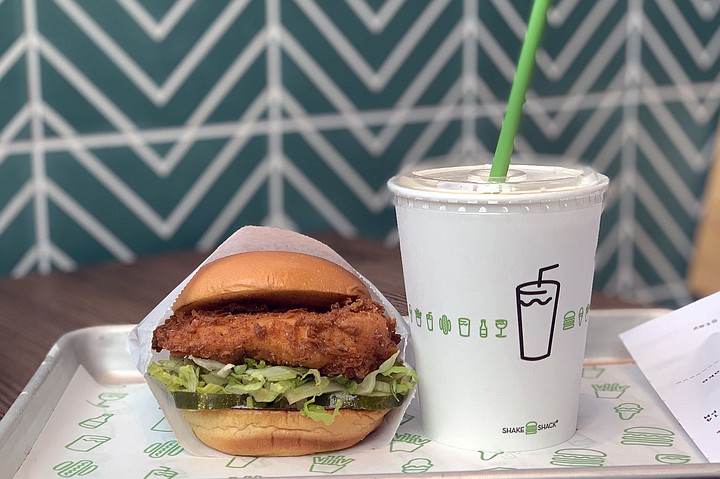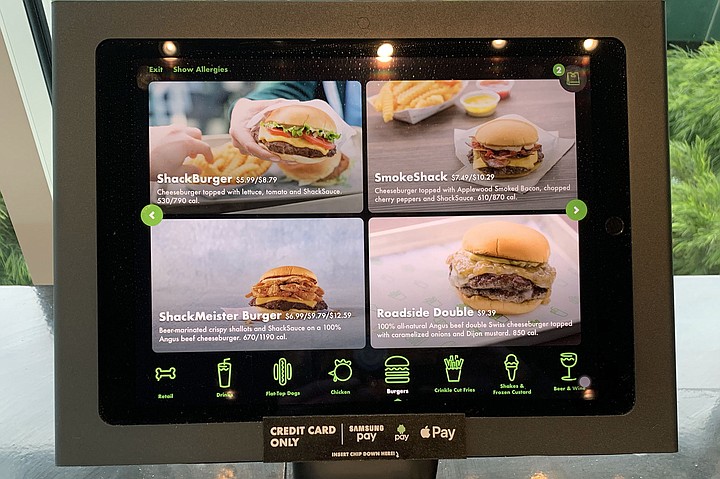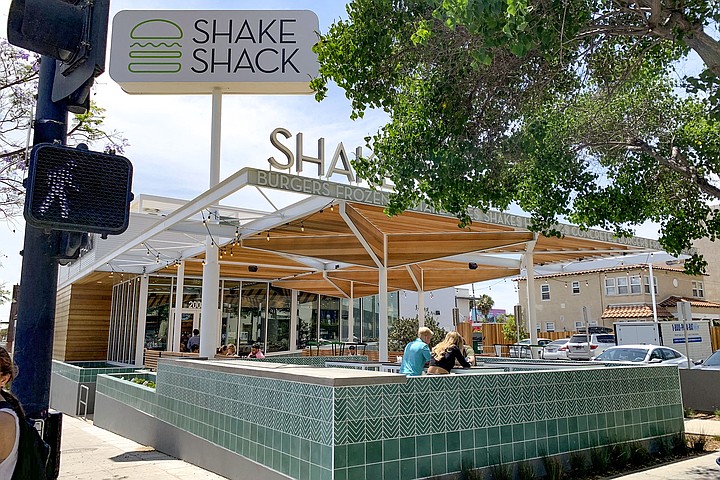 Facebook
Facebook
 X
X
 Instagram
Instagram
 TikTok
TikTok
 Youtube
Youtube

When ballyhooed East Coast burger chain Shake Shack made its way west a few years ago, all we loyal Southern California burger fans rushed to say how much we still prefer In-N-Out. And yet, somehow, Shake Shack has survived. In fact, it’s spread — the business said to have launched from a Madison Square Garden hot dog cart is up to four San Diego locations now, from Del Mar to Little Italy.
While I will never get behind Shake Shack’s crinkle cut French fries, I have come around on the rest of its food. It doesn’t hurt that the Shack pledges beef raised free of antibiotics and added hormones, and uses soft yet chewy potato roll buns. Or that you can get a bacon cheeseburger or a Vienna Beef hot dog. Or that frozen custard shakes are delicious.

It helped that a few midwestern friends, who experienced Shake Shack’s westward expansion a couple years sooner than we did, counseled me not to think of it as a new burger spot in town, but as a good place to get a fried chicken sandwich. It's when I first rolled into the Little Italy location to try that chicken sandwich that I became aware of a starker change Shake Shack brings to our fast food shores.

The first thing I encountered walking into the shop was a large group of teens, placing their orders at a bank of six touch screen devices. I could see that there no line behind the one customer speaking with the cashier at the front counter, so I walked past the adolescents to place my order the old-fashioned way.
Before you OK boomer me, it do understand the downside. That one person at the counter was that special brand of customer who relies on the service industry to round out their social life. I stood by nearly ten minutes while she asked every important question: What’s in frozen custard? What’s a potato bun? Hasn’t the weather unpredictable lately? Meanwhile, the teenagers had already seated themselves, harassed each other with straw wrappers, and received their food. That’s what I get for being a technophobe, I remember thinking, It’s little wonder Shake Shack had only one employee working the counter during the lunch rush.

So, on subsequent visits I’ve made use of the touchscreens to order. It’s easy, in the way all touchscreen apps are designed to be easy, yet frustrating in the sense that all tech devices ultimately beg to be stomped to pieces under large, thick-heeled boots. Having six touchscreens speeds up the process when six different people want to order at once, but it slows down the process for each customer. Minus the person looking for a conversation at the burger counter, it’s much easier and quicker to ask verbally for a burger, fries, and shake than it is to select the burger menu, select a burger, change the quantity to one, add to cart, then repeat for each item.

Also, the employee behind the counter never asks for your phone number. But the touchscreen wants to send you a text when your order is ready for pick up. So, I had to punch in my phone number before I could complete my order. I did get that text notification, exactly at the same time one of the human employees announced, “Order ready for Ian!”
I got a little bit of a John Henry vibe from the scene, reinforcing the notion those touchscreens are reducing the number of employees Shake Shack hires. Granted, working in fast food isn’t any more aspirational a job than drilling railroad tunnels, but insofar as people need wages, I have to once again unfavorably compare Shake Shack to In-N-Out. If you’ve ever noticed how upbeat and friendly In-N-Out employees seem compared to regular fast-food workers, it’s because the chain pays above minimum wage to start, with incentives for promotion including six-figure salaries for managers.
When nobody needs a fast-food job, I’ll happily punch in my own order. Till then, please give me someone to talk to about my burger. And if that means it takes a little longer, fine. I’ll just play on my phone while I wait.


When ballyhooed East Coast burger chain Shake Shack made its way west a few years ago, all we loyal Southern California burger fans rushed to say how much we still prefer In-N-Out. And yet, somehow, Shake Shack has survived. In fact, it’s spread — the business said to have launched from a Madison Square Garden hot dog cart is up to four San Diego locations now, from Del Mar to Little Italy.
While I will never get behind Shake Shack’s crinkle cut French fries, I have come around on the rest of its food. It doesn’t hurt that the Shack pledges beef raised free of antibiotics and added hormones, and uses soft yet chewy potato roll buns. Or that you can get a bacon cheeseburger or a Vienna Beef hot dog. Or that frozen custard shakes are delicious.

It helped that a few midwestern friends, who experienced Shake Shack’s westward expansion a couple years sooner than we did, counseled me not to think of it as a new burger spot in town, but as a good place to get a fried chicken sandwich. It's when I first rolled into the Little Italy location to try that chicken sandwich that I became aware of a starker change Shake Shack brings to our fast food shores.

The first thing I encountered walking into the shop was a large group of teens, placing their orders at a bank of six touch screen devices. I could see that there no line behind the one customer speaking with the cashier at the front counter, so I walked past the adolescents to place my order the old-fashioned way.
Before you OK boomer me, it do understand the downside. That one person at the counter was that special brand of customer who relies on the service industry to round out their social life. I stood by nearly ten minutes while she asked every important question: What’s in frozen custard? What’s a potato bun? Hasn’t the weather unpredictable lately? Meanwhile, the teenagers had already seated themselves, harassed each other with straw wrappers, and received their food. That’s what I get for being a technophobe, I remember thinking, It’s little wonder Shake Shack had only one employee working the counter during the lunch rush.

So, on subsequent visits I’ve made use of the touchscreens to order. It’s easy, in the way all touchscreen apps are designed to be easy, yet frustrating in the sense that all tech devices ultimately beg to be stomped to pieces under large, thick-heeled boots. Having six touchscreens speeds up the process when six different people want to order at once, but it slows down the process for each customer. Minus the person looking for a conversation at the burger counter, it’s much easier and quicker to ask verbally for a burger, fries, and shake than it is to select the burger menu, select a burger, change the quantity to one, add to cart, then repeat for each item.

Also, the employee behind the counter never asks for your phone number. But the touchscreen wants to send you a text when your order is ready for pick up. So, I had to punch in my phone number before I could complete my order. I did get that text notification, exactly at the same time one of the human employees announced, “Order ready for Ian!”
I got a little bit of a John Henry vibe from the scene, reinforcing the notion those touchscreens are reducing the number of employees Shake Shack hires. Granted, working in fast food isn’t any more aspirational a job than drilling railroad tunnels, but insofar as people need wages, I have to once again unfavorably compare Shake Shack to In-N-Out. If you’ve ever noticed how upbeat and friendly In-N-Out employees seem compared to regular fast-food workers, it’s because the chain pays above minimum wage to start, with incentives for promotion including six-figure salaries for managers.
When nobody needs a fast-food job, I’ll happily punch in my own order. Till then, please give me someone to talk to about my burger. And if that means it takes a little longer, fine. I’ll just play on my phone while I wait.
Comments